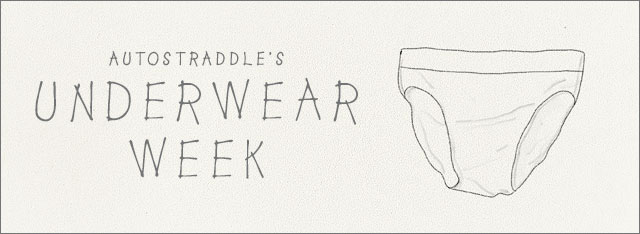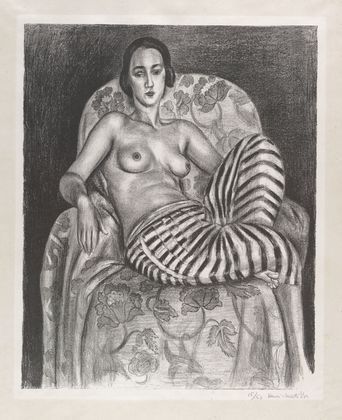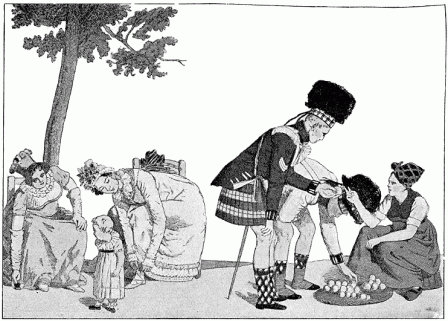Welcome to Underwear Week, a whole week dedicated to your favorite bum-hugging clothesthings. As we said many moons ago, we feel a lady is at her best when she’s not wearing pants. And while our last adventure around this neck of the woods took us only as far as boyshorts, this time around we’re exploring the vast and many-flavored land of underwear. From edible panties to hoopskirts and history, we’ve got you covered. Just like your underwear.

While the rest of Autostraddle talks about underwear, I will be talking about talking about underwear. You can’t hang out at the strip club all the time, you know? Sometimes you have to hang out at the coffee shop NEXT to the strip club and wait for the strip club to open and read the dictionary. Or something.
Some of these origins are so obvious we won’t bother unfolding them. “Underwear” is pretty self-explanatory, for example. “Drawers” you draw on, you know? And a loincloth, of course, is an undergarment worn by a lion who can’t spell. But others come from more mysterious places! As with the things they led to, some of these word histories long and some of them are short; some bare all and some remain somewhat shrouded. Read on to figure out which “traditionally women’s” underclothes used to be “traditionally men’s” underclothes (hint: all of them. All of your underwear is secretly queer and that’s why it lives in your closet).
Panties
The story of “panties,” like so many great tales, can be traced back to a Nicomedian doctor from the 3rd century. After converting to Christianity, this doctor gained miraculous healing powers — along with the suspicion of the local authorities, who condemned him to death. But when they tried to kill him, Jesus kept mucking it up:
“[His] flesh was first burned with torches; upon this Christ appeared to all . . . the torches were extinguished. After this, when a bath of liquid lead was prepared, Christ . . . stepped into the cauldron with him, the fire went out and the lead became cold. He was now thrown into the sea, but the stone with which he was loaded floated.”
They tried wild beasts, a breaking wheel, and beheading — same deal. After the doctor survived all this, he begged forgiveness for his executioners, and so was given the name “Panteleímon,” Greek for “all-compassionate.” After allowing himself to be martyred, he was venerated and became Saint Pantaleon.

Fast forward to Venice. Because of a combination of their love for Saint Pantaleon and their tendency to “piante leoni” (“plant the lion,” aka stick their roaring flag all over conquered countries), other Italians start to call them “Pantaloni.” In commedia d’ell arte, the 16th century Italian theater tradition that also brought Europe the actress and about ten billion immortal tropes, the stock character “Pantalone” was the stereotypical Venetian merchant, a “cheap and ridiculously gullible” wealthy man who wore “tight-fitting long red trousers.” By the 17th century, the French were calling trousers of this sort “pantaloons.”
Pantaloons is so much fun to say that the English started using it for all kinds of trousers. Soon after, cool kids started abbreviating it to “pants,” a trend that angered traditionalists; Oliver Wendell Holmes Sr., in his 1846 “Rhymed Lesson,” called “the thing named ‘pants’ in certain documents/a word not made for gentlemen, but “gents.” As we all know, though, even traditionalists can’t keep a good word down for long. Soon enough, “pants” had caught on enough that people were re-elongating it, this time into “panties.” By Holmes’s logic “panties” should be worn by “genties;” instead the term picked up a “somewhat dismissive” connotation, as when a character in of one of Ezra Pound’s Cantos is “my gawd scared out of his panties.”

The word “panties” started being associated with women instead in the 1930s; it shows up in the New Yorker in 1932, which is that’s how you know it’s legit. The heteronormative gender divide was legion by 1969, when well-known (but clearly close-minded) linguist Mario Pei explained, in his Words in Sheep’s Clothing, that “men, as everyone knows, wear shorts, not panties.”
Commando
Who can we thank for making going bare-assed sound so badass? It might be the Scottish military — their recently frowned-upon tendency to let ’em swing has led to the phrase “True Scotsman” as well as the term “going regimental,” perhaps “going commando”‘s predecessor. Slate’s Examiner dates this version of the phrase to 1974, where it appeared in a guide to college slang. At that time, America’s actual commandos were in Vietnam, “spending extended periods in hot, wet jungle environments,” which may explain this wardrobe decision.

Boxers
Jacob Golomb, a tailor’s son and swimmer from the Bronx, founded Everlast when he was 17 because he was fed up with poor-quality sports equipment. After he’d been in the game for about a decade, he started specializing in boxing gear. By 1925 he’d invented a pair of shorts with an entirely elastic waistband – like a little boxing ring encircling your torso – to allow for fancier footwork (and, presumably, cooler designs). He called them “boxer shorts” because he was tired after all that inventing. Briefs appeared five years later, courtesy of Jockey. Interviewers have been lazy ever since.

Bikini
The U.S. tested atomic weapons on Micronesia’s Bikini Island for twelve years starting in July 1946, and for a while, “bikini” was slang for an explosion, as in “the startled citizens could see the bikini from miles away.” Meanwhile, a French engineer and lingerie shop worker named Louis Réard realized, while engineering IN the lingerie shop, that he had invented “the smallest bathing suit in the world” and needed a suitable name for it — a name that was powerful, explosive, capable of producing immediate and lasting damage. So he went with “Bikini.” By the 1950s, the word had settled comfortably out of scare quotes and capitalization and into cultural ubiquity and every single US Weekly picture caption. “The joke at the time was that that the “bikini” split the “atom”, because it was introduced right after a tiny single-piece bathing suit called the Atome.” Hey, don’t laugh too hard! Your navel is showing.

Thong
If Sisqó lived in Proto-Germanic times, he’d be asking us all to let him see those thwangaz, or maybe those þwongs. And we probably would no problem, because he’d be talking about narrow leather cords used to bind things together. Australians started using the word “thong” to mean “sandal” in the 1960s; it made the perilous leap up the leg in the 1990s. The many years the word spent in relative innocence mean that you can still read about thong seals (bearded seals, whose hide was used to make leather), thong weed (which has “long, strap-like reproductive bodies”) and how “it is pleasant to cut thongs on another man’s leather,” aka to be lavish with something that belongs to someone else. Like someone else’s thongs. Hear that, Sisquo?









Comments
Love this! The story of the bikini is one of my favorite etymological tales :). Also, the word ‘knicker’ has traveled extensively between the US and the UK– fun stuff.
“And a loincloth, of course, is an undergarment worn by a lion who can’t spell.”
cara, i am CACKLING. way to be hilarious, my friend. now i will continue reading…
THAT SEAL THOUGH
everything about this post is quite excellent! except for that poor seal pup D:
Yes! Thankyou for that last one on ‘thong’, I’ve always hated having to correct myself to ‘flip flop’ around Americans because they would giggle and tease me for talking about underwear instead of bother to pick up a slang book at the airport. Now I have a smarmy retort about it being an Australian word first.
Sidebar appreciation for the word ‘pantaloon’.
It took me a good few years to teach my mom that saying, “Give me a minute, I just need to put my thongs on” was inappropriate to say before a beach excursion.
I laughed through this entire article. Until I saw the seal.. (is it crying?)
‘If Sisquo lived in Proto-Germanic times, he’d be asking us all to let him see those thwangaz, or maybe those þwongs.”
loving the nerdy humor and pop culture references! also the “kilt” caption punnery.
Underwear! Pantaloons! Boxing women! Victorian ladies peeking up kilts! Everything about this post is great.